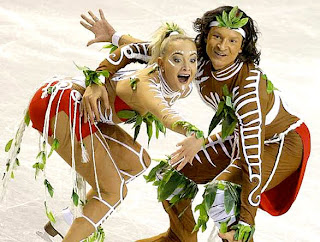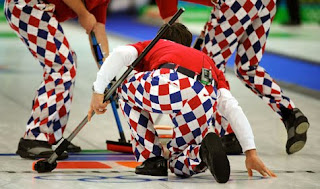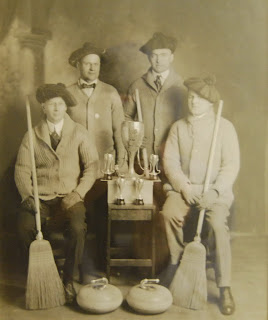
This year the Winter Olympics happened in our time zone. This means we don’t get to watch anything live. At eight p.m. the television begins to emit a steady stream of stale events, from which we can pick and choose. Figure skating is always a treat: will American favorite Lurleen Neewack be able to land the elusive quadruple-splatchnatz with the triple putz combination, or will it be revealed, upon reviewing the tape, that she came down .275 degrees past a quarter-turn on her landing skate and thus 2.3 seconds before she actually lifted off, a disqualification? Who cares? The spectator is there to see the efforts of the costumer, fresh off a stint fashioning bridesmaids’ outfits for parrots. He is facing stiff competition from the Russian team designer, who, with sequins, feathers, and several yards of baggy flesh-tone material, was able to rock the Australian Abor iginal Shar-Pei theme. From home, it looked like a toss-up.
iginal Shar-Pei theme. From home, it looked like a toss-up.
Outfits are a perfectly reasonable way to decide what to watch when dipping into Winter Olympics coverage. And that is what has drawn so many of us to that fine sport for which Curling Pants were created. We don’t even want to know what Curling Pants do; we’d rather speculate. However some understanding of the rules of Curling helps to better appreciate the sport.
Curling was invented in Scotland shortly after the discovery of heavy drinking. Each curling team consists of four members: the thrower, the skip, and two tidiers. The thrower releases a jelly doughnut made of granite with a handle on it (a “stone”), and it travels across the ice, coming to rest as close to the center of a target at the end of the sheet as possible. In order to influence the speed and trajectory of the stone, two team members aggressively tidy the ice in front of it. Stones may ricochet off other stones, displacing them, and points are awarded according to the number of stones ultimately closest to the target. It is essential for the thrower to release the stone before it passes over the “hog line,” a determination that used to be made on the honor system, but in competitive curling a special stone is used that electronically detects if the thrower’s hand is still on the stone. An electric field at the hog line will detect any infraction and cause the stone to light up like a UFO. This was designed to eliminate the need for an official, avert controversy, and perchance reduce hooliganism among the spectators. Sadly, the 2010 Olympic Curling Event was still not hooligan-free, so plans are underway for the 2014 event to create a special stone that will cause the thrower to burst into flame upon violation. At the other end of the sheet, the skip’s job is to hop up and down and scream at the other members of the team, and occasionally to finish tidying. Each team throws eight stones.

All the rest of the events can be reliably ranked by how closely they resemble curling. Bobsledding, for instance, also features teams of four, and requires a lot of stones. The first man in the bobsled is the “driver,” and the second through fourth are the “meat.”
Even closer to the ideal of curling is the Women’s Giant Slalom, in which racers are sent down the mountain every fifteen seconds or so, allowing later racers to carom off the previously crumpled or deceased entrants, and the team with the most members arriving right-side-up at the bottom of the hill wins the gold.
But our heart remains with the curling competitors, especially Canadian home-town hero Cyril “Syrup” Parfait, of Vancouver, B.C., whose parents, having seen his early promise, quit their jobs as neurophysicist and Prime Minister in order to accompany their son to the best Jamaican training facility, where they eked out the money for his coaching by taking jobs licking gym floors. It appeared that M. and Mme. Parfait would not be able to afford to attend the Olympics to cheer their son on, but thanks to the generosity of the good folks at Winnipeg Whack-A-Moose, someone was able to swing by in a Dodge Caravan and pick them up.

 iginal Shar-Pei theme. From home, it looked like a toss-up.
iginal Shar-Pei theme. From home, it looked like a toss-up.
Mark Twain would be proud of this!
Quite apart from having to wear curling pants, which are undeniably warm, but hideous, curling itself is a real yawner and when you're not freezing your feet off, waiting for your turn, you're freezing your tail off, landing on your ass every time you slip on that polished ice. Which for me was every other step.
Thanks for the belly laughs. I needed them. (I do sense the real respect for these august events underneath the humor, I do!)
I promise to pen a poignant and relevant comment on the above post as soon as I revive from my laughter-induced coma.
As a curling fan, I must tell you: those are actaully golfing pants. I herewith demand a retraction.
Let me assure you, I am a huge curling fan also, though I'm trying to lose weight. That's the Norwegian curling team's argyle curling pants. They also invented lutefisk.
So it wasn't just me who thought those Russians looked a bit wrinkled, not to mention very bizarre! (And folks complained about Johnny Weir's costumes????) And who can forget the class act that is Evgeni Plushenko (sp??) – so gracious in defeat!!! As usual, you are right on target – best not to take ourselves too seriously!
Them good Lutheran boys wore them awful pants while curling, but they are indeed golf pants: http://www.loudmouthgolf.com. It was a big news story up here, as I'm sure you can imagine. With or without lutefisk.
That's why the cry "Hurry! Hurry hard!!" or someone'll see me in these pants and take a picture!
Hey new cyber-girlfriend, it appears we have stumbled upon each other's blogs and found something in them we each admire. I lived in Canby for 10 years and I may eventually return to the Portland area. It's beautiful. I sure miss being able to get my ocean fix whenever I want. Thanks for finding me, leaving a comment and signing up to hold a flashlight for me in the dark. As soon as I took a look at your blog I knew we are kindred spirits, so I hooked on to your trailer hitch, too. I'm looking forward to the ride.
My sentiments exactly! Thanks for the hilarious post mortem. I'm having a hard time trying to type through my tears — of laughter!
No Socialized Television
You didn't mention the added joy while watching compulsory figure skating, etc., of watching compulsory repetitive TV commercials. 20 minutes in every hour (I timed it). My friend in Germany is forced to do without. When he watches an hour of olympics he gets an hour of only winter sports.
Murr, I just found you after you left the best comment ever on the subject of Feminine Hygiene on my blog. I read this post and immediately subscribed. Then I read through a few more posts and about the time I got to the one about the Newt Romance, I had to write YOU. With your permission, I'd like to point my readers and Twitter followers and FaceBook fans your way. (I do realize you won't be getting this until a few hours from now since we're on opposite ends of the country but do give me permission. E-mail me at barb@sothethingis.com)
And thank you so much. You reminded me of how I used to write before I started writing blog sound bytes. I needed the reminder and was just complaining to my Editor that I wasn't as satisfied with my work as I used to be. Thank you!!
Thanks for stopping by the blog and saying 'Hi' Murr, and a big thanks for the addition to the blogroll. I do believe we would get along famously in a non-cyber environment. We're thinking of retiring to the Great Northwest, so if you could keep that beer cold for 17 years or so, we'd appreciate it!
I awake early in the morning to prepare for my early morning drive to work. I flip on MSNBC to see if we are at war with anyone else…and during Olympic season I was greeted with Curling every morning. Staring sleepy-eyed at that stone (which costs $2,000 I learned…I wonder if it was #2,000 Canadian or US?)gliding peacefully down that stretch of ice. Perfect coffee sipping fare.
It was always women curling…and I became fascinated with the contortions that The Thrower (the stone-pusher lass) would somehow fold into as she began pushing that stone on it's trajectory.
Now thanks to you, I understand the rest of the story.
This comment has been removed by a blog administrator.
This comment has been removed by a blog administrator.
I love their funky outfits!